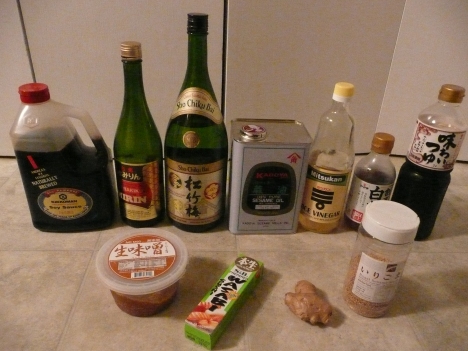It’s been a pain to be sick for over three weeks, but I got something unexpected as a gift.
We now have another sous-Kitchen Wizard at our house.
OK, he’s learning, so it’s not the same, but given that he never really cooked much for the 11 1/2 years we’ve been together, he’s far exceeded my expectations. (OK, he wants me to add that he occasionally grills and makes crepes on weekends, and pasta with pre-made tomato sauce when I’m not around. Oh, and a very nice salmon and lentil dish when I had flu 10 years ago.)
With minimum instruction and no specific recipes, he made the following:
- Various pasta dishes (one with cauliflower, two with chicken and lamb sausages & veggies, one with seafood & veggies)
- Potato with seafood & veggie sauce
- Grated lotus root & chicken burger (my favorite!)
- Carrot soup
- Sausage, potatoes and brussel sprouts (grilled)
- Brussels sprouts salad
- Brussels sprouts & sausage soup
- Sautéed cauliflower
- Cauliflower pasta
- Japanese style Tofu scramble with tuna
- Chicken with orange sauce
- Swordfish Kebab
- Chinese style seafood and veggie dish
- Braised lettuce
- Tuna and avocado rice bowl
- Spanish Omelet
And probably a few more I’ve forgotten. He’s made everything from scratch, without relying on pre-made things. (We don’t have these in our house any more.) Of course, he had a choice to go out shopping and do so, but he didn’t. I was very proud of him. No take-outs either.
Is he a genius? He’d want me to say yes, but but in reality, no, and he only had minimum cooking skills to start with. (Now definitely medium cooking skills). I realized when you give minimum yet flexible instructions, rather than a specific recipe, keep a well stocked pantry, and give people freedom to play, anyone can cook far beyond their imagination.
Before this, as far as I know, he didn’t cook much. When I’m out, I felt I had to make sure that he’d have things to eat. So when I got really sick with 104F fever and entered my version of Survivor Pneumonia, which had never happened in the past, I was worried that we may have no dinners. I was too weak to cook, and I didn’t even have any appetite.
On the first night, he kept asking “what shall we cook?” and I kept telling him, “I don’t know. I’m not even hungry”. The only thing I managed to do was 1) ask him what we had in the fridge, and 2) give him some suggestions about what he could make, and based on what he said he’d want to cook, 3) I gave him a very basic instructions and guidelines, and off he went.
It probably was helpful that I had no energy or appetite to visit the kitchen to check how he was doing.
Based on this, this is what I learned.
- With minimum direction, anyone can cook.
- Use all 5 senses, especially tasting throughout the process. Stay in the kitchen, and pay attention to what’s going on.
- A well-stocked pantry is the key – you can make various dishes depending on the mood and time available for cooking.
- Sometimes, all one needs is to change the frame work. When I had a craving for pureed soup, he thought it would be way too difficult and time consuming. When I gave him basic directions, he used his creative license, and made us a nice carrot soup, and concluded that it was quite easy.
- Most important ingredient is the freedom to play, fail and subsequently succeed.
Afraid of criticism from your family? (or worse yet, yourself?)
Make sure there’s no food police allowed in your home-kitchen. Both the cook and the diners need to have adjusted expectations. You won’t be serving your dinner for $20 per plate, so if it doesn’t turn out spectacularly, no big deal. It’s only food! Focus on what went well, and if there is an area for improvement, write it down in your Kitchen Journal, so that next time, you won’t make the same mistake.
This is also a good practice for anything you do in life. Change the way you see your accomplishments – 1. what went well, 2, what would make this even better, and how you can do that.
Praise: Give praise to the chef. Even if you find some imperfections, praise what’s good about the dish. Also the fact she or he took time to make that for you. That alone is worth the praise.
Nothing says “I love you” like home-cooked food made with love. That means no thinking about work, or fights with your family, or other concerns. People can actually taste these problems.
Cooking time can be very therapeutic after a busy day at work, if you learn how to be present and use it as a time to be creative and have fun.
Just like driving, regular practice makes it perfect. My husband was forced to cook everyday for a few weeks. Once the first week was over, he was a lot more confident cook. And if he can do that, anyone can.
So the silver lining of my survivor pneumonia episode: 1. We have another cook in the house. (I don’t have to worry about his dinner when I’m not around! Woo hoo!) 2. My husband found cooking is fun and easy. 3. We have another hobby which we can share. 4. Last but not least I now have a newfound respect for my husband.







